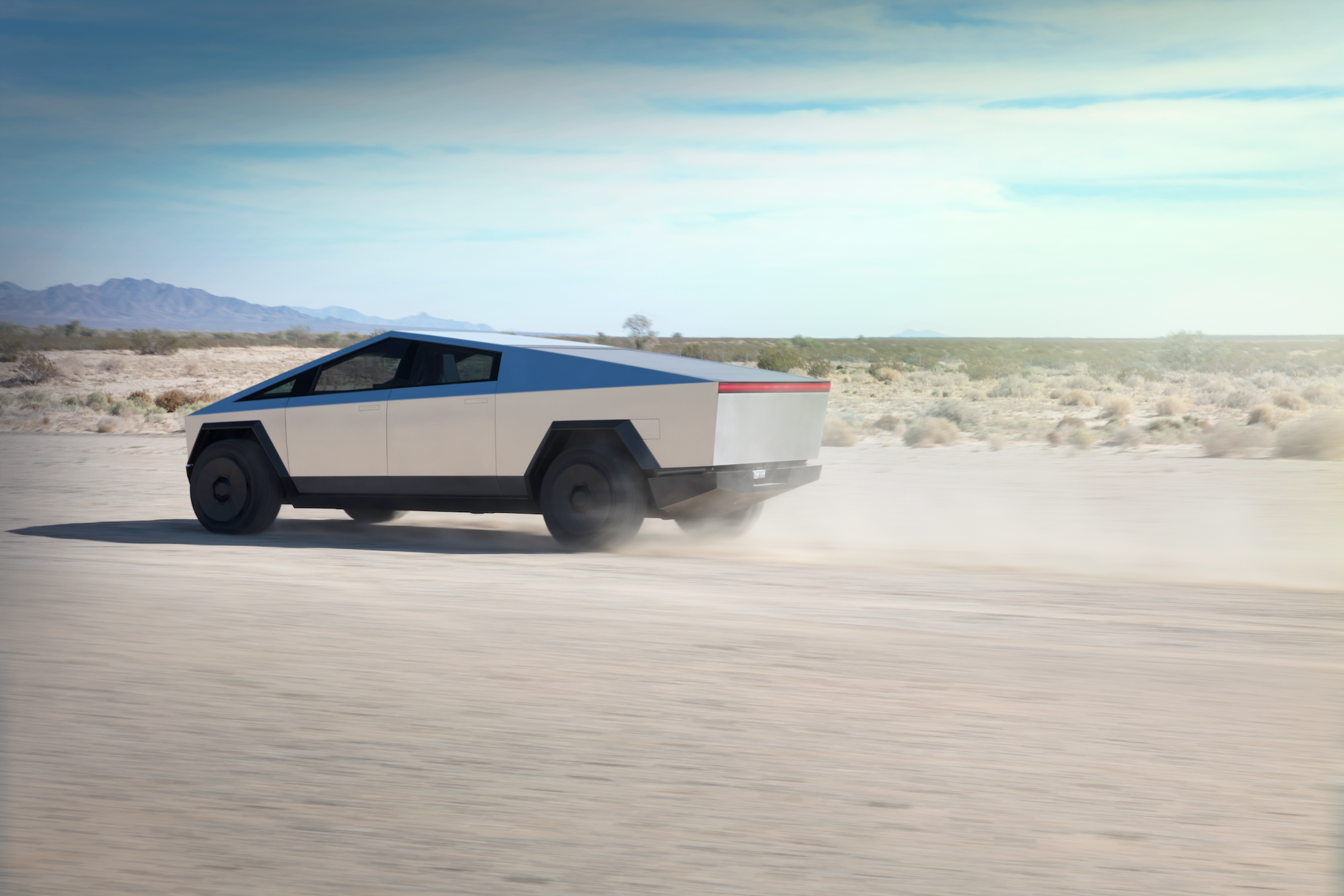What Ford F-150 owners think of the Tesla Cybertruck
 Henry Payne
Henry Payne
And now for something completely different.
A Los Angeles Auto show that started with a Ford Mustang Mach-E electric crossover taking on the Tesla Model Y, ended with Tesla in its familiar position: introducing a vehicle unlike any seen before.
The Tesla Cybertruck pickup caught the automotive world by surprise with its daring sci-fi design, segment-busting performance figures and competitive $39,000 starting price. Conversations with Metro Detroit Ford F-150 enthusiasts indicate the Tesla has their attention. But when it comes to purchase, these users all got hung up on familiar concerns about electric vehicles.

More than perhaps any other vehicle, owners of pickups raise concerns about battery range and reliability compared to gas-powered mainstays.
Detroit auto companies these days are noticeably insecure when it comes to Silicon Valley EVs and autonomous vehicles. They, too, want to be the cool kids on the block. So Ford cheekily launched its first electric SUV, the Ford Mustang Mach-E, at LA’s Hawthorne Airport right under the nose of Tesla’s design studio. The glitzy launch event featured movie star Idris Elba interviewing Ford CEO Bill Ford. Consumers applauded.
Then Tesla reminded everyone how it was done.
“The Mach E was a familiar auto industry reveal,” said Tim Stevens, an auto reviewer with C-NET’s "Roadshow" who used to cover Silicon Valley electronics. “Tesla is probably 95 percent Tesla faithful in the room, emotions are very high. Musk presents the truck and all of a sudden they are hitting it with a sledgehammer. It's a very different sort of event.”
The Tesla show was populated with lightning-shooting Tesla coils and screaming Tesla employees dressed in sci-fi costumes. When Musk strode on stage, says TFLTruck expert Roman Mica, he was greeted with screams of “I want to have your baby!” and “I want to marry you!” That doesn’t happen to other industry executives.
Then things really got crazy. Musk introduced a stainless-steel triangular pickup that looked like it had come off a Hollywood sci-fi movie set. After demolishing a Ford F150 door, Tesla designer Franz Von Holzhausen turned his sledgehammer on the Cybertruck’s doors and then chucked steel balls at its windows to prove its toughness.
Musk infamously failed in proving the shatterproof quality of the Cybertruck's “armored glass” – two windows yielded to steel balls – but such glass is not unknown to the industry. Ford itself was the first to use shatterproof Gorilla Glass on its Ford GT supercar.
The rollout was crazy, yes. But it was also an acknowledgment by Tesla that its space-age truck has to address conventional concerns valued by Detroit Three pickup owners: toughness, performance and versatility.
Ford, Chevrolet and Ram brands have ridden these attributes to dominate the biggest vehicle segment in the United States. Musk is desperate to penetrate the truck truck market to show the mass sales-potential of EVs. On the toughness front, F-150 owners I talked with were impressed by Musk’s demonstration – unconventional as it was.

They were well aware of the Cybertruck after Musk's circus show. They were unfamiliar with Rivian, Bollinger and Lordstown Motors, the other electric trucks hoping to gain traction in the pickup space.
When Ford introduced its aluminum-body F-150 four years ago, Chevy responded in a similar manner as Tesla: by dropping a toolbox on an F-150 truck bed and puncturing it. By contrast, the Silverado’s bed is made from rolled-steel. The Cybertruck’s skin is stainless steel.
My trucker focus group liked Tesla’s macho, including claimed payload (3,500 pounds) and towing (14,000 pounds) — figures that beat the Detroit Three. At $39,000 for a rear-wheel-drive model, they liked that the Tesla was priced competitively, unlike the Rivian and Bollinger trucks that are north of $70,000.
But where truckers get cold feet is in the practical application of those numbers. The Ford F-150, for example, sold nearly a million copies last year because of its gas-powered versatility.
At TFLTruck, which tests vehicles on Colorado’s challenging landscape, Mica and his team have been testing Tesla’s Model X SUV with a claimed 4,980-pound towing capability – healthy for a mid-sized SUV. But with 2,000 pounds behind it, TFLTruck finds the Model X gets just 30 percent of its predicted 325 miles of range.

For an Oakland County-based construction worker commuting 100 miles to a job site in, say, Ann Arbor, that can be an issue. To an outdoorsman driving up north on a fishing trip to the Manistee River outside Grayling, the lack of charging infrastructure in rural America is concerning. For an electrician working out of his truck in winter cold at a facility without power, battery life is a worry. The concerns translate to other battery-powered trucks entering the market as well.
Those concerns mirror the people who have tested my Tesla Model 3.
Interestingly, my truck experts did not flinch at the Cybertruck's styling. In fact, they found it refreshing. Technologically curious by nature, these Ford faithful were intrigued by the Tesla’s electronic wizardry. Put the Cybertruck design back-to-back with an F-150 and it looks like it arrived here from the future.
That said, they balked at the Cybertruck's steep bed sides that would make it difficult to pitch shovelfuls of mulch into an open bed. The innovative midsize Honda Ridgeline introduced a similarly innovative design in 2006 and was met with poor sales.
At the Cybertruck reveal, Musk's 1976 Lotus Esprit was on display. The angular sports car, which was used in the filming of the “The Spy Who Loved Me,” helped inspire the Cybertruck's unique looks.
At the Ford reveal, a picture of the 1914 Detroit Electric vehicle that Henry Ford’s wife, Clara, drove was prominently displayed. Innovative and quiet, the Detroit Electric EV failed to sell next to Ford’s popular, gas-powered Model T because it lacked range and affordability.
Henry Payne is auto critic for The Detroit News. Find him at hpayne@detroitnews.com or Twitter @HenryEPayne.